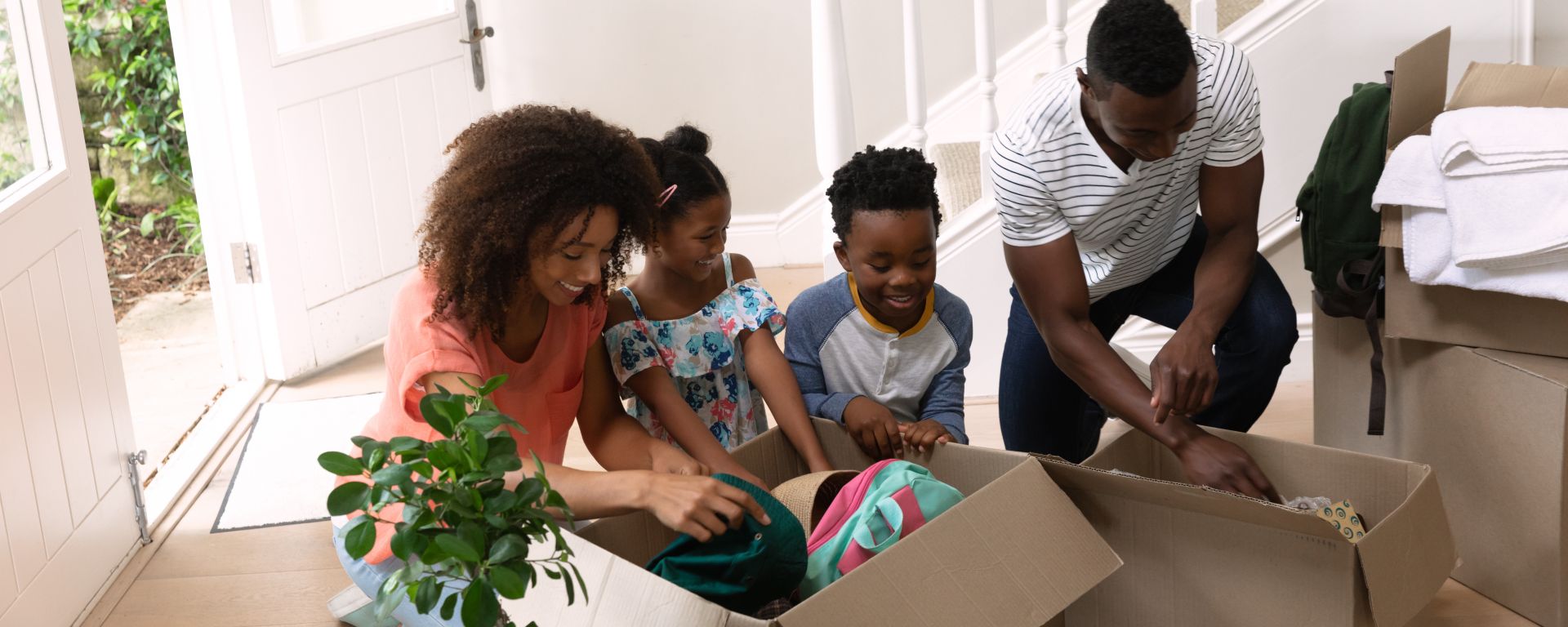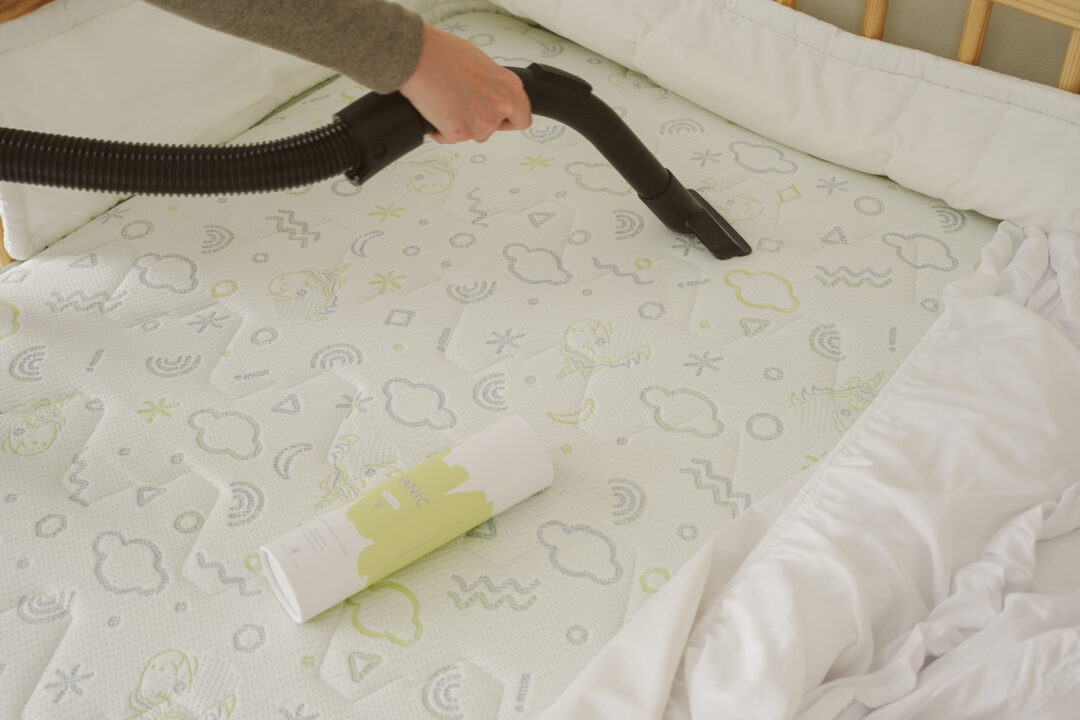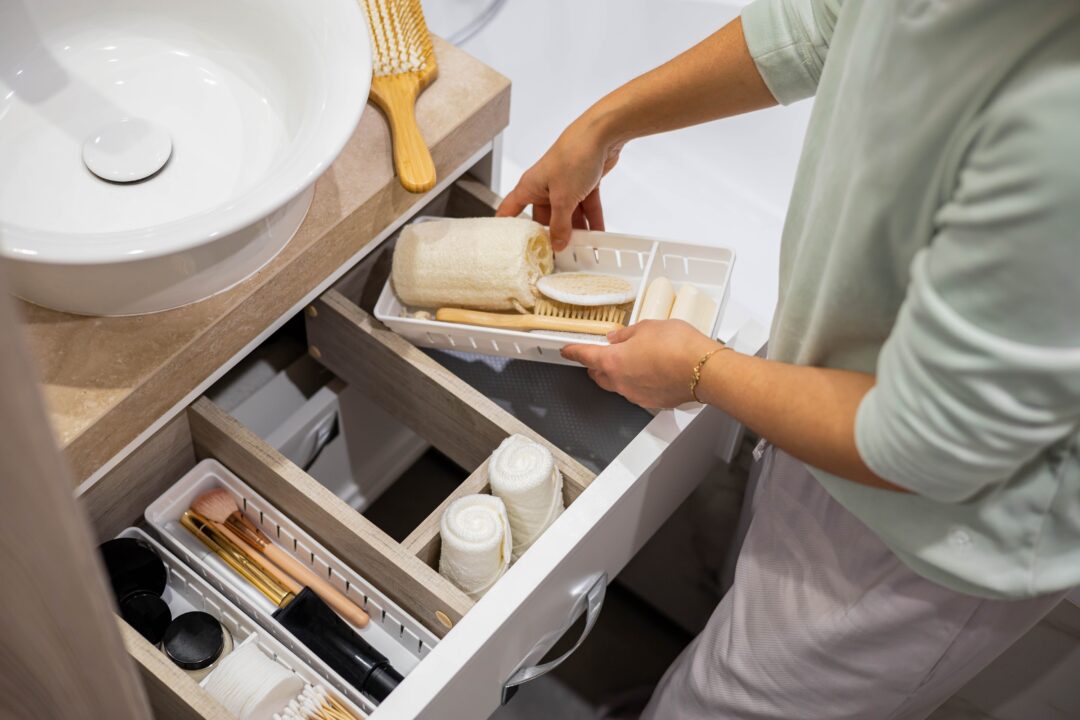If you’re moving into a new home, it’s an exciting time in your life, but it can sometimes be harder than necessary. From packing and unpacking all of your possessions, to setting up utilities and organising your new home, there is lots to be done. Use this moving checklist to keep track of your to-dos before, during and after move-in day.
There are so many details that go into moving that you may feel overwhelmed simply by thinking about it. Having a plan, making a list, and sticking to a schedule can help you get through the next few months as you settle into your new home. This guide includes certain tasks to get done weeks before your move-in day. We have created this checklist to help you organise the madness, and provide you with moving tips to help take a load off your shoulders.

8 Weeks Before
At this point, you know you’ll be living in a new home in about 2 months. Now’s the best time to start planning the move. There are a few things to research and prepare so that you’ll be ready for the moving day.
Think About How You Want To Move The Household
There are a lot of moving methods you can choose from. If you’re moving into a close-by place or you have a small budget, you will probably opt for a DIY move. This means you’ll be doing all of the packing, loading, and driving to your new home, which also means you’ll need to borrow or rent a moving truck. DIY moving also includes unloading, unpacking and assembling your furniture and appliances. It is a fair amount of work but will save your wallet in the long run.
If you’re moving to a new city or across the country, it may be wise to hire professional movers to take care of packing and transporting your items. It will cost more than DIY moving, so it’s good to weigh out the pros and cons.
A hybrid move may be the best way to save time and money. With this type of move, you hire professionals to handle some tasks, but you DIY a good portion too. For instance, you wrap, pack, load and unload your things, but you may hire a freight trailer or moving containers. After the container is loaded, the moving company picks it up and delivers it to your new house.
Don’t forget to research and read the online profiles of the top-rated movers near you. Check their experience, credentials, customer reviews and ratings. If you have more questions for them, then don’t hesitate to reach out and ask.
Once you’ve found a few moving companies that you could see helping you with the move, think about having them come to your home to do an on-site inspection and provide a free quote. You should take the opportunity to ask them to explain how they set their rates for local, long-distance, or cross-country moves.
Keep in mind that companies usually charge per hour, or sometimes per crew member.
Decide Whether You Need Additional Moving Services
Some extras may be added to your moving list. For instance, you can ask professionals if they can provide any of the following moving resources:
- Packing items into boxes.
- Moving speciality items, like a piano, artworks, hot tubs, etc.
- Unpacking your items at your new home.
- Reassemble your furniture.
When you get quotes from moving services, make sure you list everything you need right away to calculate an accurate estimate.
Research Your New Community
You may want to gather information about local banks, schools, grocery stores, hospitals and doctors. Make the necessary arrangements for your kid’s school reports, get familiar with public transport if there is any in the new area, and explore your soon-to-be community.
Take Measurements Of Your New Home
Until you place your furniture into your new home, you’re not going to know how your furniture will feel and fit into your space. But, you may want to have a slight sense of where everything is going.
Measure your furniture and appliances. Then, go room-by-room through your new home, and take measurements to get an idea of your belongings fitting. You could even create a sketch so you can map out your current furniture into your new layout. Take the time to design where things will go. Make a list of what will not fit into your new home and may have to be sold or given away.
This process will help you save money by decreasing the size and weight of the move, and also help you plan how to tell movers where to unpack boxes and items in your new home.
Schedule Time Off Work
Even if your moving date is on the weekend, you will be happy to have an extra day or two to get everything ready and in order. The extra time will help to prep, pack, move, unpack, get settled in and get used to the new drive. If you request some time off work in advance, you’ll have enough time to get used to your new home and you’ll know if you have to leave home earlier in the mornings to get to work on time.
Take Care Of Travel Arrangements
If you’re moving across the country or out of the province, it’s important to get the logistics in order. Whether it’s booking a rental car, flights or hotels, you’ll need to calculate all of your moving expenses, so it’s best to start planning and budgeting. If you’re driving, be sure to have the route mapped out. The earlier you do it, the better.
6 Weeks Before
A common mistake people make when moving is trying to move everything on their own. When you’re 6 weeks away from your moving date, start organising the items that will be coming with you to your new place, and what can be thrown away.
Take a look and evaluate everything you own, and take the time to sell, donate, or give away unwanted goods. If you don’t, you will waste money paying movers for a longer job or a bigger truck.
Clothing
Go through your closets, dressers and wardrobes in each room to figure out which clothes you or your family members have outgrown. Identify items you haven’t worn in a long time and separate them into four different categories – keep, sell, donate, and throw away.
Household Items
Once your clothes have been sorted, go through all cabinets, drawers and cupboards in your home. Throw away the junk, old newspapers, magazines, broken appliances and unwanted items that are damaged or not worth fixing. Organise your remaining household items into different piles for selling, donating and keeping.
Donate, Sell Or Throw Away
Collect all of the items you would like to donate and drop them off at a charity shop or have them taken away by a local charitable organisation. If you want to see if your items have any worth, have a garage sale or try selling the items online.
Alternatively, a junk removal company can also help you get rid of unwanted items. Look for a professional online to collect your things at a time that suits you. Junk removers can get rid of many items, including furniture, clothes, appliances and electronics.
New Appliances And Furniture
Once you’ve handled all of your old or unwanted items, you can start ordering new furniture and appliances to replace the old ones. And, if a manufacturer or brand you’re buying from doesn’t offer installation services that you require, or at a price that you can afford, start researching and booking furniture assembly and installation services near you. Being without a fridge or bed is the last thing you want to deal with after moving into a new home.
4 Weeks To Go
With only a month left now, it’s time to start placing your belongings into boxes. You have four weeks left of living in your current space, so you should decide what and when to pack everything up. For example, don’t become too ambitious and box everything such as all of your pots and pans if there’s still some time left, you could end up with nothing to cook with for the remaining time.
Buy Packing Materials And Moving Supplies
To make your move cost-effective and efficient, put everything into moving boxes. That way, the movers don’t end up wasting time trying to work out how to secure loose ends in the back of the moving truck.
You will want to stock up on lots of moving boxes in a range of sizes – small, medium, large and extra large, for different purposes, such as wardrobe boxes, moving boxes made for dishes, and more. And you’ll want to be sure that you get enough sellotape, bubble wrap and packing paper to go along with them.
Other moving supplies you may need:
- Furniture sliders
- Moving blankets
- Moving straps
- Scissors or a craft knife
- Plastic bags
- Packing peanuts
- Duct tape
- Cleaning supplies: paper towels, broom, glass cleaner etc.
Separate The Essentials From The Valuables
Any item that is used daily or is of high value should be moved with you, whether you’re driving or flying to your new community. So you may want to think of what you can’t go without.
These include things like medication, toiletries, bath supplies, contact lenses or solutions, pet food, personal records and information, documents (driver’s licence, identity document, passport, legal, certificates), photos, family heirlooms and jewellery. These things should be set with the fragile items before you begin packing. During the move, try to keep your most valuable items and documents close to you.
Star Packing And Labelling Boxes
Go through every room in your home and make a list of what needs to be put into boxes. Itemise large items, like furniture and appliances, and decide on a labelling system for all moving boxes. You may want to do the following:
- Pack all of your items that you haven’t set aside already for every day.
- List each item in every box, and put a label on the outside and inside of the box.
- On your boxes, write down what room it should be placed in. You can also make a colour-coded system that indicates what the box contains and where it should be placed.
- Carefully wrap fragile items and clearly label the box “fragile”
If you currently live in a studio apartment or one-bedroom place, you will probably be able to pack everything within a weekend. But, for a 3-bedroom home or larger, it will likely take up to a week to pack. You can always hire a packing service to help you develop a system for packing and wrapping your items before your moving day.
Final Arrangements Before Moving Day
To ensure you’re fully prepared and ready for move-in day, tie up a few loose ends and get your existing home ready for the movers. Here are some things you should check:
- Double check with the movers that they’re arriving on the agreed date and on time. Make sure they know exactly where to go, park, and which elevators to use when moving boxes into your new home.
- Confirm whether you’ll pay by credit card, cash or check, and be sure to have some extra cash on hand if you would like to tip the moving crew.
- Don’t forget to submit a change of address form at the post office or home affairs. Your mail will be sent to your new home, and you’ll probably also receive coupons for new furniture, lights and services.
- Notify banks, credit card companies and insurance companies of your new address too.
- Forward medical records to new health providers.
- Confirm school transfer details for your children at their new school if necessary.
- Find someone to take care of your small children and pets for a few days while you’re arranging everything into your new home and getting settled.
2 Weeks Before
The moving day is almost here. At this stage, you should almost be done with packing. The last 2 weeks involve completing small tasks that will help to ensure a quick and easy move.
Here’s a 2-week moving checklist to help you stay on schedule:
- Make sure to update your address. Try to do this at least 4 weeks in advance, but 2 weeks is also acceptable.
- Continue packing moving boxes. You might be tired of the bubble wrap and tape, but you’ll be grateful when this task is complete.
- If you’re moving long-distance, confirm and double-check your travel arrangements.
- You may want to hire a cleaning company, like SweepSouth, to do a final move-out clean of your current home. Hopefully, you’ll be able to get some of your deposit back. While you have the chance, book a deep clean for your new home before moving in.
- Fill any important prescriptions that take some time to set up in a new area.
- Confirm delivery dates of your new furniture and appliances to your new house.
- Use up any perishable foods in your home that will not last for the move.
2 Days Left
Almost there now! Now you should be ready to complete a few more packing and organising tasks. Once you move, there will be a couple of days without everything you want. Doing some prep work on the last few days can help you get through the first few days of living in your new place:
- Pack your suitcase. Every family member should pack a suitcase as if they’re going on holiday for a few weeks. Pack enough clothes, medication and toiletries to get through a period without having to rummage through your belongings.
- Confirm all details with the moving company, home cleaning service, and other professionals who will be assisting with the move.
- Walk through every room one last time, and make sure you don’t forget anything before leaving your home. Get rid of leftover items by hiring a junk removal company or arranging a donation pick-up.
- Confirm that utilities will be turned off at your current home a day after you move out and that the utilities in your new home will be turned on by the time you move in.
- Do a final cleaning of the appliances you’re taking to your new home. For example, refrigerators should be emptied and defrosted before the moving day.
- Clear a path to the front door, and make sure there’s an easy parking space for the movers too.
Move-In Day
You’ve finally made it to the moving day! The work you’ve done up until this point will pay off on the day to ensure everything goes as smoothly as possible. There are still a few things you’ll need to take care of on moving day before you head over to your new home:
- Collect all of the valuables and essentials set aside earlier, and make sure to pack them with you.
- Check and make sure everyone in the family has their suitcase or overnight bag packed.
- If any items are staying behind, make sure they are marked, or remember to tell the movers.
- Do a final sweep to ensure all of your belongings are out of your home and that the moving company has every item on your inventory list. Pack up your family and head over to your new home.
Move-in Checklist: Steps To Take After You Move In
Moving into a new home is an exciting experience, but it can also be a daunting one. Once you set the last box down and the final piece of furniture has arrived, it can be incredibly overwhelming. You may wonder what to do next, or what project you should tackle first. This new home checklist will help you prioritise what you need to get done after a big move.
Days After You Move In
When you move into a new home, ensure the utilities are set up in your name. It may be a good idea to call your service providers ahead of time. This helps to ensure that your lights are on the first day of arrival.
Find the companies that offer services in your area, and determine which utilities you need to set up, such as electricity, heat, gas or internet. When setting up your water, you should be sure of where the shut-off valves are located on the property. This will be important for you to know, especially in case of a plumbing issue.
Inspect Your Home For Safety Hazards
Whether you’re moving into your very first home, or settling down in a retirement apartment, your home must be a safe place to live. For this reason, hiring a few professionals to inspect key aspects of your home is a good idea.
In many cases, a home inspector will assess your home during the initial buying process. But after moving in, it never hurts to double-check a few items. For example:
- Start with electrical and wiring inspection. A professional electrician can help you determine if your home needs any critical electrical or wiring repairs or upgrades. Handling these in a timely fashion is a necessity for yours and your family’s safety.
- Then, inspect your plumbing. Check to make sure that there aren’t any leaks inside your home, and be sure to test the hot water. A plumber can tell you if you need any important repairs. Sorting this out right away can save you from dealing with costly repairs later on.
- Inspect your home’s smoke detectors and carbon monoxide alarms. The batteries will likely need replacing.
Identify Necessary Home Repairs
During the first few weeks of being a new homeowner, you may want to thoroughly examine your home’s interior and exterior. The goal is to pinpoint critical repairs and potential issues that may arise over the next couple of weeks. Prioritise the items that may be a risk to your safety or cause further damage to your property.
Exterior Checklist
When it comes down to the exterior of your home, a good place to start is the roof. A professional roofing company can tell you if your roof needs critical repairs or maintenance services.
After inspecting the roof, you’ll want to walk along the outside of your new home and be sure that there’s no peeling paint, damaged siding, or other noticeable damage to your home.
Here is an understandable list of the areas you should keep an eye out for in and around your home. In some cases, a handyman may be able to tackle the repair. Other times, repair work may require a licensed contractor.
- Damaged or missing shingles and tiles.
- Chipped house paint.
- Damaged siding.
- Fences that are leaning or have panels missing.
- Rotting wood, including the patio or deck.
- Landscaping issues, such as falling trees, broken sprinkler heads, etc.
- Mould on the roof, siding, or other outdoor structures.
Interior Checklist
Now that we have already gone through the benefits of inspecting your home’s electricity, plumbing, and alarms when you move into your new home, you should also find out if you need a repair service to help you with the following:
- Uneven flooring
- Holes in the walls
- Chimney and fireplace issues
- Chipped or faded paint
- Mould – you’ll need to check for signs of mould in your walls, attic, and moisture-prone areas of your home.
Lastly, don’t forget about pests. For instance, if you notice signs of termites, cockroaches, mice, and other critters, it’s highly recommended that you call in a professional.
Deep Clean Your Home
Deep cleaning your home is important if you’re moving into an older home or a rental. Write down an outlined list of everything you think needs to be cleaned. From the inside of the fridge, to the walls behind your bath, to the inside of each toilet in your home, be sure not to leave any items off the list.
Also, you may want to consider prioritising deep cleaning before you’re done unpacking. This makes cleaning easier for certain areas of your house that will later be covered by rugs and furniture items. Then, gather your cleaning supplies, grab the broom, and get ready to make your home sparkly clean. Or perhaps you may want to hire a professional to deep clean your home instead. House cleaning can be a time-consuming task, and a professional will usually have the right equipment to ensure your new home is thoroughly cleaned promptly.
In some cases, you’ll want to hire a pro who has specialised cleaning expertise. For example, you may need to hire someone to polish your hardwood floors or steam clean your carpets, so that you don’t have to clean your carpets by hand.
Start Unpacking
Unpacking always seems like the easiest part of getting settled into your new home, but for those who work for long hours or have little kids at home every day, unpacking can feel like a monumental task to overcome. The good news is that you can make the process a bit more simple. Follow these tasks for a swift unpacking experience:
- Put boxes into the designated rooms. Place boxes with kitchen supplies into the kitchen, and the boxes with bedroom items, such as hangers, into the correct bedrooms.
- Make a list of priorities. What things are you going to need as soon as you move in? Paper towels may take priority over your set of favourite books. Those important must-have items should be unpacked first.
- Consider getting additional help. If your schedule looks as though it is going to be hard to have the time to unpack, hire an unpacking service to assist.
Assemble Furniture
You may buy new furniture to fill the new home or you would have taken apart your furniture in your old home for the move. Regardless, it’s time to put everything back together.
First, move the furniture items into the various rooms you want them placed in. This will help to prevent misplacing items or moving items through hallways that are too small. Make sure that you have all the necessary tools needed to assemble the furniture. If any pieces were lost during the move, find the replacements before you get down to reassembling. If the furniture is too intricate or complicated, or you’re too tired or stressed to do it yourself, hire a professional to help. There are lots of professionals near your area who can assemble the furniture for you.
Install New Appliances
You may have bought new appliances, particularly if your fridge was too old to move across the country. Or perhaps you’ve been checking out the latest gas stove range. Whatever the case may be, adding appliance installation to your move-in checklist is a must.
Before you get in touch with professionals, be sure to make a list of everything, including the fridge, washing machine, dryer, oven etc, that needs to be installed. As you make your list, take note of items that were installed in a certain area before you moved in. For example, if you’re installing a dishwasher, will a plumber need to come and add new water lines to the specific area?
Appliance installation can sometimes be dangerous. It usually involves hooking up electricity, adding plumbing lines, or even piping in new gas lines. Whatever the case may be, calling a professional is the best way to go.
Change Locks To Secure Your Home
One of the key parts of feeling at home in any new environment is making sure the area is secure. Whether you have just moved into your first home, or this is one on a long list, you will want to keep yourself and your loved ones safe.
Double-check all of the locks and door handles. If you notice a lock not working or a loose doorknob, make note of replacing these items or hiring a locksmith or handyman to do the work for you.
You should also think about installing a home security system. A professional will be able to help fit your home with a state-of-the-art alarm system. Many modern home security systems can be controlled through your phone when you’re away. If your home already has an alarm system installed, then simply test it; you might find that you need to replace the batteries.
Weeks After
Organise your home.
Now that your items have been unpacked and your furniture has been assembled, you can turn your focus to home organisation. Your old storage solutions may not work as they used to. Instead of putting everything in the first place you can think of, set aside some time to organise systems that will work best.
The recommended home organisation isn’t just about figuring out where things go when you’re not using them, it’s about setting up a system for your house where the things that flow in and out, like the laundry, mail and people, will make the most sense and ease of use.
Schedule Routine Maintenance
It’s crucial to stay on top of home maintenance tasks so you boost or retain your home’s value. The best way to ensure that you don’t forget anything is to build up a team of home maintenance professionals you can turn to for routine maintenance and emergency repairs. Here are some pros that you will want to add to your list:
- Electricians
- Gutter cleaners
- Handypeople
- Home cleaning services
- Lawn care services
- Pool cleaners
- Painters
- Pest control services
- Plumbers
- Roofers
Once you’ve found the right people, add their contact details to your phone. You’ll be grateful that there is someone you can call whenever a leak or switch needs repairing.
Months Later
Once you’ve been able to enjoy and relax in your new home, you may want to start to think about the possibilities of what you can do to make your home more enjoyable, energy efficient, or valuable.
Whatever home improvement project you take on, it’s best to start planning earlier rather than later. The earlier you start, the sooner you can create a budget and find the necessary designers and contractors who can help you make your dream home a reality.
Conclusion
You will find that the best months to move are the colder winter months, from mid-April until the beginning of September. During these months, there is typically less demand, so moving companies may be willing to charge less due to the season.
Once you’ve settled into your new place, don’t forget to book a move-in clean with the company that does it all. The SweepSouth team is ready to make the transition from old to new as easy and stress-free as possible.








